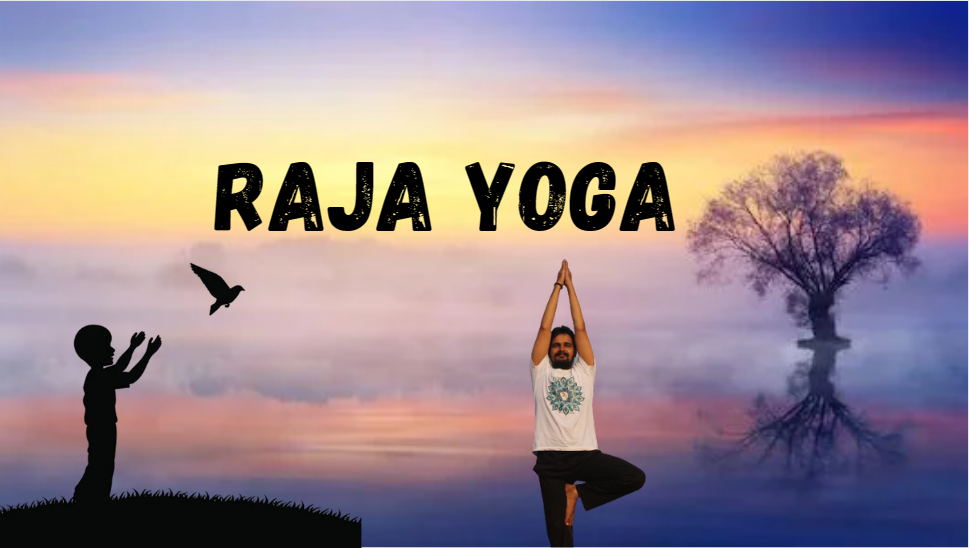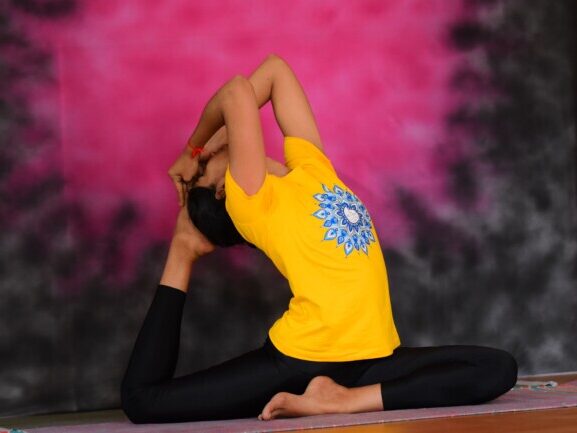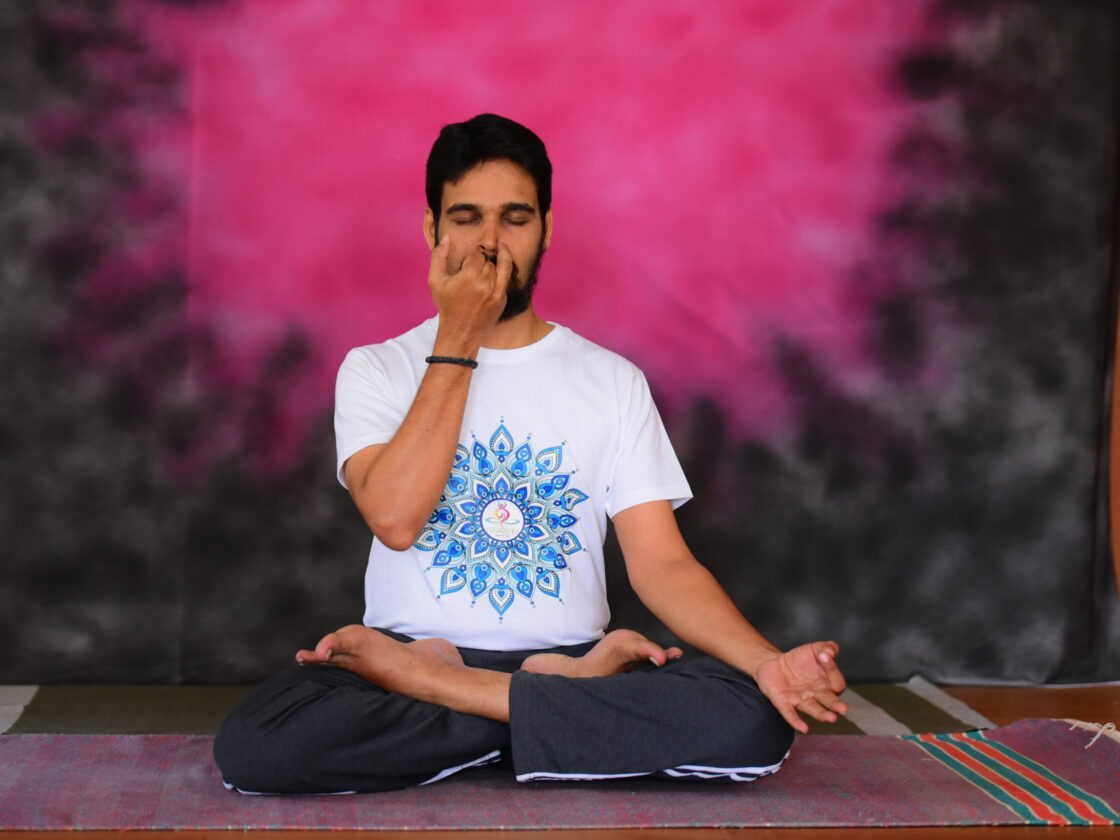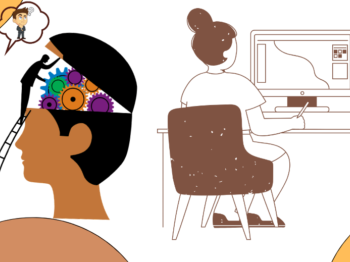From Novice to Yogi:
“Learn How Raja Yoga Can Completely Change Your Life with these 8 steps”
“यमनियमसन प्रनयमप्रत्यहर धरन ध्यन समधयोऽस्तवन्गनि”

Compiled by Maharshi Patanjali, raja yoga is also known as ashtanga yoga, because its practices can be divided into eight limbs. Swami Vivekananda defined ashtanga yoga of Patanjali as raja yoga.
Raja yoga is the royal path of yoga. As a king maintains control over his kingdom, one ca maintain control over his own “kingdom”—the vast territory of the mind. So, Raja yoga is the path of systematic analysis and control of the mind. In Raja yoga one uses his mental powers to realize the Atman through the process of psychological control. The basic premise of raja yoga is that our perception of the divine Self is obscured by the disturbances of the mind. If the mind can be made still and pure, the Self will automatically, instantaneously, shine forth.
According to Shivayogadipika of Sri Sadashiva Brahmendra Saraswathi, there are four types of yoga, out of them Raja yoga is the superior one. He defines Raja yoga as
“ज्ननोपय मनोव्र्त्ति रहितो रजयोगवित्” २५
“Jnanopaya manovrtti rahito rajayogavit”25
Sri Sadashiva Brahmendra Saraswathi
Raja yoga is that state, where there is no knowledge, no thoughts, and no citta vrttis.
This is the scientific, step by step approach to yoga. Systematically the mind is analyzed. Techniques are applied to bring it under control and to achieve higher states of consciousness.
Understanding the 8 Limbs: Raja Yoga
Ashtanga Yoga or Raja Yoga derives its name from the Sanskrit words “Ashta” meaning eight and “Anga” meaning limbs. These eight limbs, outlined by the sage Patanjali in the Yoga Sutras, serve as a roadmap for spiritual growth and self-realization.
The Ashtangas are as :
“यमनियमसन प्रनयमप्रत्यहर धरन ध्यन समधयोऽस्तवन्गनि”२६
“Yama-niyamasana pranayama-pratyahara, dharanadhyana samadhayo’stavangani”26
1. Yama (ethical principles).
2. Niyama(Rules and regulation).
3. Asana (Postures).
4. Pranayama (controlling the respiration).
5. Pratyahara (controlling the sense organs).
6. Dharana (Concentration).
7. Dhyana (Meditation).
8. Samadhi (Self realization).
Yoga is more than just a physical discipline. It is a way of life—a rich philosophical path. The eight limbs of raja yoga are the good common-sense guidelines for leading a healthier, happier life for bringing spiritual awareness into a social context. The practice and perfection of the limbs of yoga leads to Samadhi.
1. Yama (Restraints):
The first limb focuses on ethical principles and moral disciplines. Practitioners are encouraged to cultivate virtues like truthfulness, non-violence, and non-attachment, laying the foundation for a harmonious existence.
The Yamas collectively provide a moral code for ethical living, encouraging practitioners to extend their awareness and consideration beyond themselves to the broader community. By practicing the Yamas, individuals aim to create a foundation of ethical behavior, fostering compassion, truthfulness, contentment, moderation, and non-attachment. This ethical foundation lays the groundwork for the subsequent limbs of yoga, facilitating personal and spiritual growth. The Yamas guide practitioners toward living in harmony with themselves, others, and the world.
“अहिम्ससत्यस्तेय ब्रह्मछर्य परिग्रह यमह्.” २७
“Ahimsasatyasteya brahmacharya parigraha yamah.”27
The five yamas are: Non-violence, truthfulness, non-covetousness, continence and non-receiving.
I. Ahimsa
(non-violence):
According to the Yajnavalkya Samhita, ahimsa or non-violence is the awareness and practice of non-violence in thought, speech and action. It advocates the practices of compassion, love, understanding, patience, self-love, and worthiness.
II. Sathya (Veracity or Truthfulness):
Patanjali describes truthfulness as: “To be in harmony with mind, word and action, to conduct speech and mind according to truth, to express through speech and to retain it in the intellect what has been seen, understood or heard.” A perfectly truthful person is he who expresses in his speech exactly what he thinks in his mind and in the end acts according to it. One should be truthful in word, action and deed. Always speak the truth and never to distort it or tell lies.
III. Asteya (non stealing):
Non-stealing or asteya is the third constituent of the yamas. It upholds forgoing the unauthorized possession of things by violating the code of conduct through thought, speech and action. Asteya stands against covetousness and envy. It advocates the cultivation of a sense of completeness and self-sufficiency in order to progress beyond base cravings.
IV. Brahmacarya
(continence):
Which means to exercise restraint on yielding to impulse or desire or any of the bodily activities. The senses should not be distracted from being focused on Brahman, the supreme.
V. Aparigraha (Non
–receiving):
The literal meaning of apigraha, is the non-accumulation of worldly objects, caused by covetousness and attachment. The commentator Vyasa says that this last state of yama is attained when one remains totally detached from sensual pleasures of all kinds and so effectively refrains from committing himsa or violence of any sort. One should not receive anything from anybody, even from nature, which is not really essential to one’s life.
2. Niyama (Observances):
Niyama involves personal observances and self-discipline. It includes practices such as contentment, self-study, and surrender to a higher power, fostering inner strength and resilience.
The Niyamas provide a framework for personal and spiritual development, guiding individuals to cultivate positive qualities and attitudes. By practicing the Niyamas, individuals aim to create a supportive and nurturing environment for their personal growth and spiritual journey. These observances encourage cleanliness, contentment, self-discipline, self-study, and surrender to a higher power. The Niyamas, when integrated into daily life, contribute to the overall well-being and spiritual evolution of the practitioner. They complement the Yamas and lay the foundation for the subsequent limbs of yoga, fostering a holistic approach to living.
Their practice harnesses the energy generated from the cultivation of the earlier yamas.
“शौच सन्तोस तपस्वध्ययेस्वर प्रनिधननि नियमह्.” ३३
“Sauca santosa tapasvadhyayesvara pranidhanani niyamah.”33
Internal and external purification, contentment, mortification, self-study and surrendering to god are the five niyamas.
I. Sauca (Purity):
‘Sauca’ is physical as well as mental purification. The physical purification is done by cleaning the body externally and internally. Mental purification means to get rid of afflictions.
II. Santosa
(Contentment):
Santosha involves the practice of gratitude and joyfulness—maintaining calm at all costs. This gives rise to inner joy.
III. Tapas (Austerity):
Austerity, which gradually leads to the removal of afflictions, and thereafter the senses attain a higher discerning power.
IV. Swadhyaya (Self Study):
According to the commentator Vyas, self-study or swadhyaya consists of scriptural studies. The scripture being, the Vedas and Upanishads together with the recitation of the ‘Gayatri’ Mantra and the ‘Om’ manthra.
V. Iswara Pranidhana
(Surrender to Lord):
Ishwar-Pranidhan, is the dedication of all our actions, performed either by intellect, speech or body, to the Divine. The results of all such actions are dependent upon Divine decision.
3. Asana (Postures):
Asana means yogic postures in harmony with one’s inner consciousness. It aims at the attainment of a sustained and comfortable sitting posture to facilitate meditation. Asanas also help in balancing and harmonizing the basic structure of the human body, which is why they have a range of therapeutic uses too.
Patanjali, defines Asana as:
“श्थिरम् सुखमसनम्.” ३९
“Sthiram sukhamasanam.”39

Purpose of Asanas:
*Physical Health:
- Asanas help improve flexibility by stretching and elongating muscles and joints.
- Many asanas require the engagement of various muscle groups, contributing to overall strength.
- Balancing poses enhance coordination and balance.
*Mental Well-being:
- Holding asanas requires focus, promoting mental concentration and mindfulness.
- Asanas, especially those that involve deep breathing, can alleviate stress and induce a sense of calm.
- The practice of asanas encourages the integration of the mind and body.
Spiritual Growth:
- Asanas are often performed with a heightened awareness of breath and body, fostering a sense of presence.
- The practice of specific postures is believed to stimulate the flow of prana (life force energy) through the body, aiding in spiritual development.
- Asanas prepare the body for meditation by promoting comfort and stability.
4. Pranayama (Breath Control):
Pranayama is the practice of breath control and regulation. The word “pranayama” is derived from two Sanskrit words: “prana,” meaning life force or vital energy, and “ayama,” meaning expansion or restraint. Pranayama involves conscious manipulation of the breath to enhance physical, mental, and spiritual well-being.
Pranayama is a powerful tool for enhancing overall well-being and deepening one’s yoga practice. It serves as a bridge between the physical and spiritual aspects of yoga, promoting harmony and balance within the practitioner. As with any aspect of yoga, it is recommended to learn pranayama under the guidance of an experienced teacher, especially for those new to the practice.

Purpose of Pranayama:
*Control and Regulation
of Prana:
- Pranayama helps balance the flow of prana throughout the body.
- It enhances the vitality and life force energy.
*Mind-Body Connection:
- Practicing pranayama cultivates a deep awareness of breath, connecting the mind and body.
- Regulating the breath induces a state of calmness and reduces stress.
*Mental Clarity and
Focus:
- Pranayama practices promote mental focus and concentration.
- Deep, controlled breathing calms the mind and reduces mental chatter.
*Enhanced Respiratory
Function:
- Pranayama techniques improve lung capacity and efficiency.
- Efficient oxygenation of the blood contributes to overall well-being.
*Preparation for
Meditation:
- Pranayama serves as a preparation for meditation by calming the mind and refining concentration.
- It activates and channels subtle energy for spiritual practices.
Tips for Pranayama Practice:
Posture:
Sit Comfortably: Choose a comfortable seated position with a straight spine.
Relaxed Shoulders: Keep the shoulders relaxed to allow for natural breathing.
Breath Awareness:
Conscious Breathing: Stay fully present with each breath.
Observation: Observe the qualities of the breath, such as depth, length, and rhythm.
Gradual Progression:
Start Slow: Begin with simpler techniques and gradually progress to more advanced practices.
Build Duration: Increase the duration of your practice gradually.
Consistency:
Regular Practice: Consistency is key to experiencing the full benefits of pranayama.
Daily Routine: Incorporate pranayama into your daily routine for optimal results.
Mind-Body Connection:
Focused Attention: Direct your attention to the breath, fostering a mind-body connection.
Integrate with Asana: Combine pranayama with asana practice for a comprehensive yoga experience.
5. Pratyahara (Withdrawal of Senses):
Pratyahara is often referred to as the withdrawal of the senses. It involves redirecting the focus of the mind from external stimuli to the internal landscape. The word “pratyahara” is derived from two Sanskrit words: “prati,” meaning against or away, and “ahara,” meaning food or anything taken into the body.
In this context, “ahara” refers to sensory experiences. Pratyahara is a transformative practice that plays a crucial role in the progression of the yogic journey. By consciously withdrawing attention from the external world, practitioners create a space for inner exploration and self-discovery. Through regular practice, individuals can cultivate a heightened awareness, emotional equanimity, and a more profound connection with the inner self.
Purpose of Pratyahara:
I. Sense Control:
- Pratyahara involves consciously withdrawing attention from the external sensory world.
- By practicing pratyahara, one learns to control and regulate the senses.
II. Internalization:
- The practitioner turns the attention inward, exploring the inner mental and emotional landscape.
- Pratyahara fosters a deepening connection between the mind and the body.
III. Preparation for
Meditation:
- By withdrawing from external distractions, pratyahara prepares the mind for meditation.
- It helps reduce mental chatter and distractions, creating a more focused state of mind.
IV. Emotional Equanimity:
- Pratyahara involves cultivating a sense of detachment from sensory experiences.
- By not being overly influenced by external stimuli, one can maintain emotional balance.
V. Increased Awareness:
- The redirection of attention allows for a more profound awareness of the inner self.
- Practicing pratyahara encourages mindfulness in daily life.
6. Dharana (Concentration):
The last three limbs of Ashtanga Yoga are the three essential stages of meditation. Dharana involves developing and extending our powers of concentration. This consists of various ways of directing and controlling our attention and mind-fixing skills, such as concentrating on the chakras or turning inwards.
It means concentration. Dharana is concentrating the mind on any single point. Holding the mind onto some particular object is dharana.
The object of concentration may be internal or external. It stimulates the inner awareness to integrate the inner flowing intelligence and releases all tensions.
7. Dhyana (Meditation):
Dhyana is the state of meditation, when the mind attains the ability to sustain its attention without getting distracted. Strictly speaking, unlike the other six limbs of yoga, this is not a technique but rather a state of mind, a delicate state of awareness. This state rightfully precedes the final state of samadhi. It consists of maintaining the concentration on a single form irrespective of the time factor.
8. Samadhi (Union):
Samadhi, or total absorption, is the ability to become one with the True Self and merge into the object of concentration. In this state of mind, the perceiver and the object of perception unite through the very act of perception—a true unity of all thought and action. This is the acme of all yogic endeavors—the ultimate ‘yoga’ or connection between the individual and the Universal Soul!
It is the state of ultimate realization. When the state of dhyana is maintained for a longer time without interception it merges into Samadhi. Samadhi is a state where the form of object of concentration vanishes and only it’s meaning exists. In the state of samadhi one perceives only the internal sensations and the meaning unexpressed in any form.
States of Samadhi:
I. Savikalpa Samadhi:
With Seed: In this state, there is still a trace of duality, and the practitioner may experience a subtle sense of separateness.
Object of Meditation: The meditator may still be aware of the object of meditation.
II. Nirvikalpa Samadhi:
Without Seed: This is a state of complete absorption where all sense of duality dissolves.
Formless Unity: The practitioner experiences a formless unity with the object of meditation,
transcending individual identity.
Purpose of the 8 Limbs:
The eight limbs of Raja Yoga are not merely a set of practices but a comprehensive guide for harmonizing the
physical, mental, and spiritual aspects of life.
Each limb serves a distinct purpose:
- Yama and Niyama provide the ethical and moral foundation necessary for personal growth.
- Asana and Pranayama enhance physical and mental well-being, promoting balance and vitality.
- Pratyahara, Dharana, and Dhyana prepare the mind for meditation, fostering inner awareness and mental focus.
- Samadhi represents the ultimate goal, a state of transcendence and unity.
The eight limbs of Ashtanga Yoga or Raja Yoga collectively provide a systematic and progressive approach to spiritual evolution. From establishing ethical foundations to achieving union with the divine, each limb contributes to the overall development of the practitioner, fostering physical health, mental clarity, and spiritual awakening. The journey through these limbs is both transformative and integrative, leading individuals toward a more harmonious and purposeful way of life.
How to Practice the 8 Limbs?
Practicing the eight limbs of Raja Yoga involves a systematic and progressive approach, gradually incorporating each limb into your daily life under proper guidance of Yoga Guru. By integrating the eight limbs into your life in a personalized and mindful way, you embark on a transformative journey that goes beyond the physical postures, leading to a harmonious and balanced existence.
Here’s a practical guide to incorporating the eight limbs into your daily life:
I. Begin with Yama and Niyama:
Cultivate virtues like honesty, compassion, and self-discipline in your interactions and daily activities.
II. Integrate Asana and Pranayama:
Establish a regular physical practice, incorporating yoga postures and breath control. This builds strength, flexibility, and breath awareness.
III. Progress to Pratyahara:
Gradually withdraw attention from external distractions. Create a dedicated space and time for introspection.
IV. Develop Concentration (Dharana):
Focus on a chosen point, whether it’s your breath, a mantra, or an image. Start with short sessions and gradually extend the duration.
V. Cultivate Meditation (Dhyana):
Transition from concentration to meditation. Embrace moments of stillness, allowing thoughts to arise and pass without attachment.
VI. Strive for Samadhi:
Understand that Samadhi is a state of profound spiritual realization that unfolds with dedicated practice over time. Embrace the journey, appreciating each step.
Conclusion
In conclusion, Ashtanga Yoga or Raja Yoga is a profound system that offers a holistic approach to well-being, encompassing the physical, mental, and spiritual dimensions of life. By understanding and practicing the eight limbs, individuals can embark on a transformative journey towards self-discovery, inner peace, and union with the divine.
Embark on this enriching journey with Ashtanga Yoga, embracing each limb as a stepping stone towards a more vibrant, balanced, and harmonious life. As you delve into the practice, remember that the true essence lies not just in achieving the postures but in the mindful integration of these transformative principles into every aspect of your being. Let the journey unfold, and may your practice illuminate the path to a more fulfilling and purposeful life.


